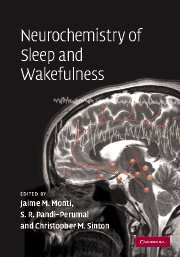Book contents
- Frontmatter
- Contents
- List of contributors
- Preface
- Acknowledgements
- Abbreviations
- I The neurochemistry of the states of sleep and wakefulness
- II The influence of neurotransmitters on sleep and wakefulness
- III Changing perspectives
- 10 Melatonin and its receptors: biological function in circadian sleep–wake regulation
- 11 Sleep regulatory factors
- 12 Adenosine and sleep–wake regulation
- 13 Prostaglandins and the regulation of sleep and wakefulness
- 14 Neuropeptides and sleep–wake regulation
- 15 Orexins in sleep and wakefulness: rodent models of narcolepsy–cataplexy
- 16 The relevance of experimental pharmacology to currently available sleep–wake therapeutics
- Index
- Plate section
15 - Orexins in sleep and wakefulness: rodent models of narcolepsy–cataplexy
from III - Changing perspectives
Published online by Cambridge University Press: 23 October 2009
- Frontmatter
- Contents
- List of contributors
- Preface
- Acknowledgements
- Abbreviations
- I The neurochemistry of the states of sleep and wakefulness
- II The influence of neurotransmitters on sleep and wakefulness
- III Changing perspectives
- 10 Melatonin and its receptors: biological function in circadian sleep–wake regulation
- 11 Sleep regulatory factors
- 12 Adenosine and sleep–wake regulation
- 13 Prostaglandins and the regulation of sleep and wakefulness
- 14 Neuropeptides and sleep–wake regulation
- 15 Orexins in sleep and wakefulness: rodent models of narcolepsy–cataplexy
- 16 The relevance of experimental pharmacology to currently available sleep–wake therapeutics
- Index
- Plate section
Summary
Introduction
Although the past decade has witnessed many advances in the basic science and clinical practice of sleep medicine, perhaps none has been more significant than the discovery of the orexin (also called hypocretin) neuropeptides that are produced in the lateral hypothalamus (LH). Failure of orexin signaling causes narcolepsy–cataplexy in humans and animals. In this chapter, we briefly review current knowledge about orexins and the symptoms of narcolepsy–cataplexy in humans. We discuss the molecular genetic analysis of the narcolepsy–cataplexy syndrome through phenotypic characterization of rodents genetically modified to be deficient in orexins or orexin receptors. These studies point to the mechanisms by which orexins promote arousal and gate sleep in normal animals; they thus have important therapeutic implications for disorders of sleep and wakefulness. We conclude with recent data implicating melanin-concentrating hormone (MCH), a related hypothalamic neuropeptide system, in the modulation of arousal. Orexin and MCH may act in concert to stabilize vigilance states, suggesting a more significant role for the LH in sleep–wakefulness regulation than previously appreciated.
The orexin neuropeptide system
Orexins are two hypothalamically expressed neuropeptide sequences, the gene for which was described concurrently and independently by two groups using different biochemical and genetic approaches (de Lecea, This volume, de Lecea et al., 1998; Sakurai et al., 1998).
- Type
- Chapter
- Information
- Neurochemistry of Sleep and Wakefulness , pp. 402 - 432Publisher: Cambridge University PressPrint publication year: 2008



